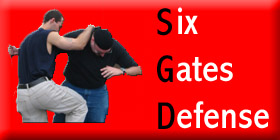its paid sponsors, whose products you need!
“Stay ‘unreasonable.’ If you
don’t like the solutions [available to you], come up with your
own.”
Dan Webre
The Martialist does not
constitute legal advice. It is for ENTERTAINMENT
PURPOSES ONLY.
Copyright © 2003-2004 Phil Elmore, all rights
reserved.
SWCA Six Gates Defense
By Phil Elmore
Sifu Anthony Iglesias of the Syracuse
Wing Chun Academy had an idea. He wanted to create a brief but
substantive self-defense course that could be taken in a single day or pair of
days by both casual students and enrolled membership alike. In fact, he
wanted all of his current long-term students to take the class — not just
one-time seminar attendees.
“Six Gates” refers, among other things, to a drill
done in Wing Chun Kung Fu in which the student protects herself from strikes
launched at high, middle, and low lines from either direction by
simultaneously counterattacking and striking the incoming limb(s). Taking his inspiration from this, the program Sifu Iglesias created is a
“combatives” course called Six
Gates Defense. Drawing from his extensive Western Boxing background
as well as Kung Fu styles (Wing Chun, White Crane, et al) and even some Aikido
and Karate, Sifu Iglesias has created a program he believes to be both easily
and quickly learned by any student.
The principles of the program are drawn directly from Wing
Chun (as you would expect). These include protection and awareness of
the body’s centerline, using both hands at the same time, refusing to fight
force with force (meaning not trying to “muscle through” a technique
straight on), striking in an efficient and linear fashion, targeting pressure
points and nerves, fighting on and moving to the opponent’s blind side when
possible, developing “touch-go” reflexes that train the student to
react to offered force, staying close (infighting), and developing the proper
mental attitude for aggressive and realistic self-defense.
Following the Six Gates Defense curriculum, students first
learn a very basic guard stance — a “fence,” of sorts, that
involves placing the hands up in a palm-open, “keep your distance”
position that guards the head and (to a lesser degree) the centerline of the
body. From this position they learn the basics of moving forward, back,
to the sides, and at diagonals from a standing, bent-knee position. Sifu
Iglesias emphasizes natural movement above everything, capitalizing on the
natural tendencies of an individual confronted by a threat.
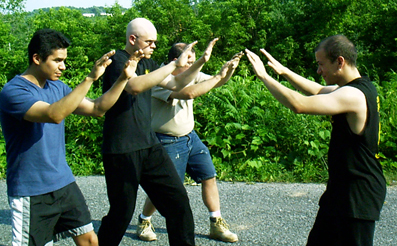
Basic Six Gates Defense guard stance.
Basic punching, drawn primarily from Western Boxing,
follows. I will say from the outset that I liked this facet of the SGD
curriculum least — because I despise horizontal punching and consider it
dangerous to the hand. Still, I could see perfectly Sifu Iglesias’
point. People instinctively punch horizontally more often than not, at
least judging from most of the new Wing Chun Kung Fu students’ brief
difficulty adapting to the vertical “sun fist” that is Wing Chun’s
primary punching tool.
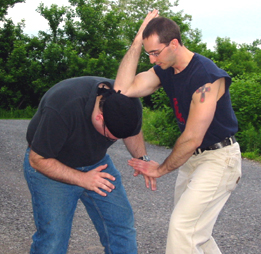
The SWCA’s senior student, Don (right)
teaches the author a valuable lesson
about necks and elbows.
Punching techniques covered included jabs, crosses,
uppercuts, and combinations of these. Students also learn to use elbow
strikes and hammerfists, tools I prefer and which I found far preferable to
the horizontal punches.

Sifu Iglesias benefits from extensive experience as a
boxer.
Blocking an incoming strike is instinctive for many
people. Blocking an incoming weapon — a knife, primarily — is also
something that could make the difference between severe injury and fast
death. Blocking techniques taught in the SGD curriculum again focused
primarily on instinctive responses, with hard, sharply angled blocks used to
provide some amount of protection from knife-bearing limbs.
Given the name of the course, a certain
amount of the Wing Chun blocking and striking with which Sifu Iglesias’
students are familiar is naturally included.
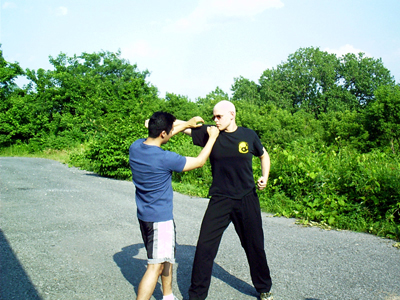
Blocking and counterattacking an incoming punch.
No discussion of realistic self-defense is complete without
at least some treatment of groundfighting. Wing Chun Kung Fu is
alternatively promoted as focusing on “anti-grappling” (thus
refusing to play the dangerous street game of fighting on the ground) and
excoriated as too weak where grappling skills are concerned. Sifu
Iglesias chose to focus on a few effective and simple techniques designed to
counter incoming attacks (while the defender is on the ground and the attacker
is not) and to neutralize ground grapples (such as side and top mounts) in
order to regain one’s feet. Some of the techniques involved rolling up
the attacker’s lower body in a way that would actually do injury to the
attacker in real scenarios.

Sifu Iglesias (bottom) begins to counter a grapple.
Because the focus of the SGD curriculum is “real
life” threats, weapons are also covered. These include basic knife
defenses, firearms counters at close range (including handguns and
longarms), and defenses against clubs and bats. This material was, for
obvious reasons, popular with most of the students. I found it on
target, too (though Sifu Iglesias and I spoke at length about whether the
knife attacks were what one should realistically expect).

The SWCA’s senior student, Don (right)
teaches the author a yet another valuable
lesson, this time about knives and knees.
Sifu Iglesias rightly pointed out in teaching handgun
disarms, for example, that one should grasp and redirect the weapon,
not the hand or the wrist of the weapon-bearing limb. It is, after all,
the barrel of the weapon that you seek to move off line. Mindfulness of
where “innocent bystanders” might be was also covered.
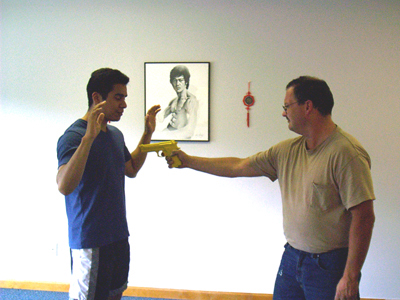
The attacker gets too close with his handgun…
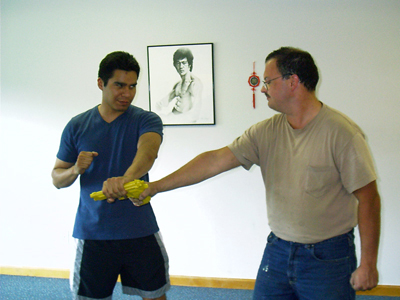
…Enabling the defender to turn and push it off
line. This must be
done extremely quickly and is incredibly dangerous.
On the whole I found the Six Gates Defense program
worthwhile. It covered all the basics and bases of physical self-defense
in modern times and would be a great way to give people without previous
experience at least something with which they could defend themselves
(though the individual’s drive and willingness to fight back viciously will
always be the deciding factors).
Of course, Sifu Iglesias hopes that the average student does
not stop after taking this single course. He would prefer that those who
begin their “martial arts” experience with such a seminar would go
on to become long-term students, learning physical and mental principles that
will serve them well for the rest of their lives.
A few hours is no substitute for long-term
training and regular practice, after all.

